Julie Webb-Pullman: Oaxaca – Means and Ends
Oaxaca – Means and Ends
By Julie Webb-Pullman
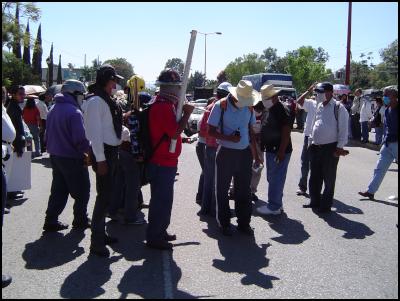
Man With Bazooka At Beginning Of March
The Popular Assembly of the Peoples of Oaxaca (APPO) protest marches in Oaxaca of 20 and 25 November have seen an unprecedented escalation of violence, the former resulting in over 50 requiring hospitalisation and more than 100 detained, and that of last weekend in at least 3 deaths, scores requiring hospitalisation and scores more injured, and more than 150 detained by police. Whilst on 20 November the police activity was largely confined to attacks on marchers, on 25 November the indiscriminate police tactics of Atenco were evident, with people being rounded up off the street, and houses entered and people seized from within them. Government sources on Monday confirmed the arbitrary nature of the detentions, advising that only some 50 of the 152 “officially” detained on Saturday night appeared before the court on Sunday, and the rest were freed because they did not participate in the confrontation between police and marchers.
While it is clear that brutal and disproportionate force has been used by state and federal authorities against anyone present including bystanders, the media, the APPO and its supporters, and that arbitrary detention has not only been committed but admitted to, it is also true that the “peaceful” intentions of some of the marchers is also now in question.

Marchers En Route…
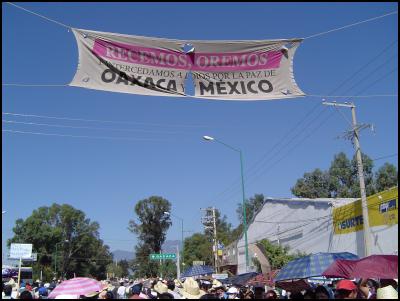
Click for big
version
Banner - Oaxaca divides
Mexico….
On November 20 there were eye-witness reports from APPO supporters that there was physical provocation of the PFP by some of the “guys who were with the APPO”. My own personal experience on 25 November was similar. I participated in the 10 km peaceful march from Animas Trujano to the centre of Oaxaca, together with about another 50,000 people. Many marchers, including myself, carried or wore cloth or surgical masks in case CS gas was used against us. In one of the front rows was a marcher with a home-made bazooka and ‘skyrockets’. The presence of such weaponry on a peaceful march seemed incongruous to say the least – whilst gas masks might be understandable as a ‘defensive’ and protective measure, a bazooka is in another category entirely.
The day was hot and sunny, and as with the last megamarch I attended, many locals lined the streets to cheer and support the marchers, and to provide refreshments. While the Red Cross handed out bags of water, local women offered baskets of mandarins to thirsty marchers.
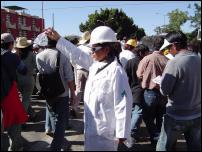
Red Cross hands out water

Click for big versions
Mandarins for the marchers
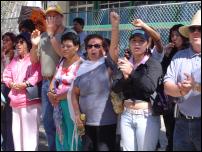
Supporters line the route
After several hours, the march arrived in the city centre, where Preventive Federal Police (PFP) had tanquettes, wire, and police lines barricading every street, maintaining a one-block protective blockade of the Zócalo in all directions. The marchers circled the blockade a block from the police lines, and while the majority then dispersed, some 4,000 remained, spread throughout the intersections facing the police lines. I and my friends walked between several intersections, where similar stand-offs were evident, taking photos.
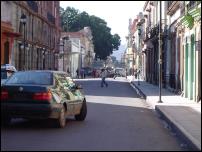
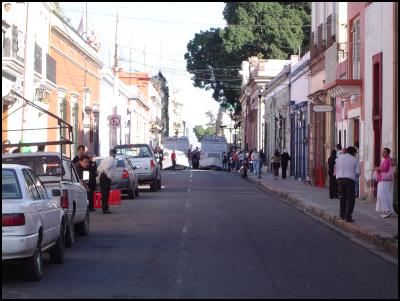
Click for big versions
Oaxaca's citizens continue to use the streets
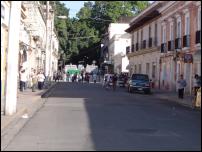
An hour or so passed, with marchers chanting slogans, and sometimes abuse, but local citizens continued to use the streets, walking through and in front of police lines, and some even ventured into the no-man’s land between protestors and police – but not without fear. This woman and her child started out bravely enough but clearly became afraid, and started running towards the protestors, waving a white cloth, where they were welcomed with laughter and applause.
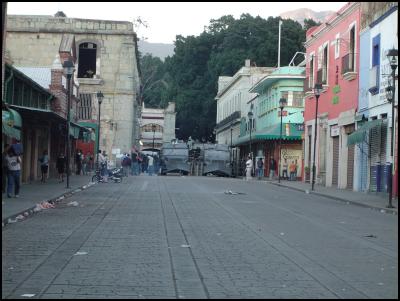
Click for big version
Minutes before the bazookas started firing
Shortly after this incident, members of the group of protestors I was standing in began firing bazookas, the first into the air, the second towards the tanquette at the end of the street along which until minutes earlier locals had been walking, and which misfired and struck a shop doorway, and the third which went straight as an arrow, exploding under the tanquette at the end of the street. Everyone cleared the intersection and waited for the police response, which was several minutes in coming – CS gas canisters then began falling, one landing above me on the awning of the shop I was next to. People scattered in all directions – my two friends and I ran to the next intersection but that too was now under gas attack, as was the next, and the next. The air was ringing with explosions and a cloud of gas began rising above the city centre. Realising it was a full-scale assault, eyes, skin and every mucous membrane burning, we ran down a sidestreet, and following the directions of locals eventually managed to find refuge at the university.
As the evening and next day wore on, reports of dead, disappeared and injured flooded in, from others like us seeking refuge at the university, from callers to the university radio station, and from medical and human rights workers, and we realised the extent of the operation. Not only had police attacked marchers in the city centre and snatched innocent people off the street and from their houses, but they also attacked the ADO bus station, and even tourists had to flee for safety.
By Sunday afternoon federal forces had surrounded the university and helicopters flew overhead. PFP and paramilitary made attempts on the barricade at Cinco Senores, the last bastion between the city and the university, and there were rumours of an imminent attack on the university. Tension was high, and Sunday night was spent on red alert.
Monday morning, the planned march was about to leave from the university to Santo Domingo, to rebuild the plantón destroyed by police on Friday, when word was received that the PFP had just announced that any manifestation would be considered a provocation and met with repression. Considering the deaths, injuries and detentions of the weekend, the march was cancelled.
Fox falls, Calderón curtseys to the right
The events of 20 and 25 November have undoubtedly upped the ante – there are rumours of the army being brought in to ‘restore order’ to Oaxaca, despite the obvious solution being the exit of Ruiz and the PFP. There is clearly a complete lack of responsible leadership from the Federal Government – while Fox appears to have suffered a series of three transitory ischemic attacks over the past weekend, the last resulting in a facial injury when he lapsed into unconsciousness and fell flat on his face, officials continue to deny he has any health problem compromising the performance of his duties. His Lady-in-Waiting Felipe Calderón, due to take office in a few days, promised “a firm hand’ in the run-up to the elections, leaving little hope that there will be a negotiated agreement to the crisis in Oaxaca – and indeed, in all of Mexico - despite calls from almost all sectors of Mexican society, including the churches, for such a course. All indications are that force will be the dish of the day, and the blood of the people, the salsa.
Does the means justify the end?

Woman and child walking…. then running…
Click for big versions
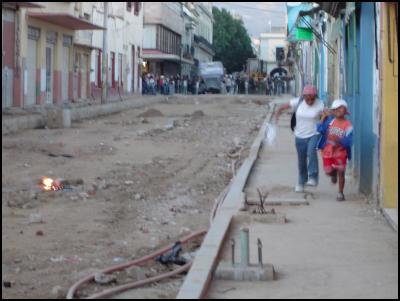
Click for big version
Not only the Mexican Federal Government needs to ask itself this question (although in their case, the end is as questionable as the means), but also some of the “elements of APPO”, as they have been referred to in the Mexican press in recent days.
The APPO has consistently claimed to be a movement of peaceful resistance, and on the whole that is true. Through a series of peaceful occupations, congresses and marches enjoying the overwhelming support of the people of Oaxaca, they have sought the ouster of corrupt and fraudulently elected Governor Ulises Ruiz Ortiz, and more lately the withdrawal of Federal public forces who have occupied the city. APPO is not merely a movement of negatives, however – they have also been working for many months on developing the form for a truly representational body to govern the state, and on identifying and working on the numerous constitutional, legal and other reforms that will be needed to transform the workings of the state at all levels such that it does indeed become democratic – of the people, for the people, and by the people. What is occurring in Oaxaca is nothing less than a popular revolution.
As in any such broad-based revolutionary movement, there are inevitably different points of view on many things. Such diversity is eminently desirable - it helps to ensure the genuine growth and renewal of ideas and practices essential to confront a constantly changing world, and to prevent the inertia that has so often beset revolutionary movements of the past, when control was seized by one faction, or a ‘party’, resulting in just a different set of entrenched and privileged elites.
Similarly, there is a wide variety of people, and inevitably in the APPO there are going to be some Rambos, along with the Ghandis and the Che’s, the Zapatas and the Juarez’s, and the ordinary folk.
And as in most revolutions, there have been deaths, injuries, and detentions – power brokers rarely give up their privileges without a fight and a flexing of their institutional muscle. Oaxaca has already had more than its share, directly as a result of state government and federal police and paramilitary repression. The victims of this repression, participants in legitimate and peaceful public gatherings, are all, by any definition, martyrs. The actions of State and Federal forces have not only irreparably damaged the national and international standing of the Mexican government, but have also afforded the APPO and its supporters the higher moral ground in this respect. But how long will this last?
The appearance in recent marches of weapons of assault, such as bazookas, detracts from perceptions of ‘peaceful’ intentions, and however broad-based the movement, such armed ‘elements’, and the rest of the APPO, must ask themselves some tough questions. If public perceptions are important, do those of armed marchers really serve the best interests of the people of Oaxaca, and of Mexico in the long run. If they are indeed committed to peaceful resistance, why didn’t the APPO security at least, if not other marchers, object to the presence of these weapons on a peaceful march? This is clearly a quite different and distinct issue from that of defending or protecting a barricade, a plantón, a radio station in an autonomous zone, or an autonomous zone itself, where such weapons may indeed be not only appropriate, but necessary. Do not armed displays such as this not play into the hands of critics?
Might not armed Rambos on a march endanger not only the higher moral authority of the participants, but also their lives, liberty and wellbeing?
I can only speak from my own experience on 25 November, but I can say for certain that there was no police aggression or attack in that or nearby streets, despite several bazookas being fired in the preceding hour or so, until three bazookas had been fired in quick succession by persons from within the ranks of the APPO, the last of which scored a direct hit, exploding beneath a tanquette at the end of the street. I saw this with my own eyes – the three launches from near where I was standing, the midair explosion, the misfire into the doorway, and the direct hit. In my opinion, these were deliberate and provocative actions that any reasonable person could expect the police to respond to – and they did. Whether whoever fired them was a member of the APPO or a police provocateur, or a combination of these, I obviously cannot say. Similarly with the 20 November provocation, whether the “guys who were with the APPO” were genuinely APPO members/supporters or police provocateurs is equally unclear. But they know who they are, and who they are affiliated with.
In my opinion, the person/s firing those bazookas in the incident I witnessed on 25 November (which from my limited point of view, and the timing, appeared to be the catalyst for the subsequent carnage), bear/s considerable responsibility for the events that then followed – the deaths, the injuries, the detentions. If police provocateurs, they succeeded in their mission to initiate a bloody and deadly confrontation between protestors and the PFP that would not only discredit the APPO but also justify the Federal Government declaring a state of ingovernability, and the intervention of the army, which appears increasingly likely.
If not police provocateurs, but ‘elements’ of APPO, they and the APPO need to ask themselves a few more tough questions. Does the small Rambo element of a large popular movement have the right to endanger the lives, liberty and wellbeing of other members and supporters of APPO attending such marches in good faith, and residents of and visitors to Oaxaca, by initiating armed action against police during what they were fully aware was a peaceful march? If the APPO is committed to peaceful resistance, and has people responsible for security at marches, why did they permit weaponry such as bazookas to be carried by participants in the march, whether police provocateurs or APPO supporters, which could potentially be used in provocative actions? Whilst their frustration may be understandable, if APPO “Rambos” are involved, it is obvious they need, and deserve, better mentors – can and will the APPO provide them?
The APPO has a grave responsibility, not just to Oaxaca but to Mexico and beyond. The path they have peacefully cleared is now being followed by many more, as the Popular Assembly of the Peoples of Mexico (APPM) demonstrates – let us hope they are not now sidetracked by Hollywood heroes.
ENDS


 Eugene Doyle: The Fall Of Saigon 1975 - Fifty Years Of Repeating What Was Forgotten
Eugene Doyle: The Fall Of Saigon 1975 - Fifty Years Of Repeating What Was Forgotten Peter Dunne: Dunne's Weekly - Trump's Tariffs Still Pose Risks For New Zealand
Peter Dunne: Dunne's Weekly - Trump's Tariffs Still Pose Risks For New Zealand Keith Rankin: Barbecued Hamburgers And Churchill's Bestie
Keith Rankin: Barbecued Hamburgers And Churchill's Bestie Gordon Campbell: On Why The US Stands To Lose The Tariff Wars
Gordon Campbell: On Why The US Stands To Lose The Tariff Wars Eugene Doyle: Before It’s Too Late - Reimagine New Zealand’s Military Future
Eugene Doyle: Before It’s Too Late - Reimagine New Zealand’s Military Future  Binoy Kampmark: Gender Stunts In Space - Blue Origin’s Female Celebrity Envoys
Binoy Kampmark: Gender Stunts In Space - Blue Origin’s Female Celebrity Envoys